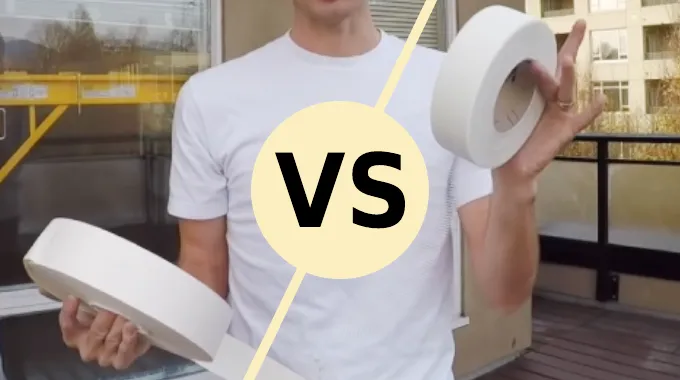Last Updated on January 26, 2023
Joints between two pieces of drywall without tape are weak points that easily fracture if external stresses are applied. If these seams are not reinforced with tape, cracks and bulges may develop over time, making repairs nearly improbable. Choose the appropriate non-shrink drywall joint tape to ensure a flawless finish.
Taping drywall provides an extra layer of protection against moisture and humidity, preventing future cracks and disintegration of the drywall’s surface. Besides creating a tight bond between drywall panels, taping also fills in any irregularities or gaps, resulting in an even surface. But which drywall tape should you use, drywall mesh tape or paper adhesive tape?
Though these two types of tape are meant for the same purpose, there are a few key differences between them. By reading on, you will discover the differences between drywall mesh and paper tape and which is the best option for you.
Drywall Mesh Tape vs Paper Tape: What are the Differences?
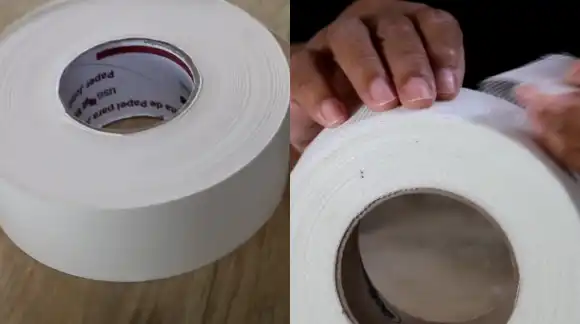
When it comes to drywall taping, most professionals have their preferences. While paper and mesh tape are popular for finishing and concealing joints between drywall panels, each option has different characteristics.
The following are the main differences between drywall mesh tape and paper adhesive tape:
01. Type of Application
Mesh tape is made of self-adhesive fiberglass and offers excellent reinforcement, while the paper tape is more flexible and easier to apply.
Drywall mesh wall tape is best used to hide blemishes or tricky corners that can’t be covered with paper tape. It’s also reinforced, making it ideal for larger surface areas and more load-bearing spaces, such as walls that need to hold a heavy coat of paint or texture.
On the other hand, paper tape requires the edges of a freshly applied layer of joint compound to be feathered for proper adhesion before sticking onto wall surfaces.
Paper drywall tape is best used inside corner joints as it lies flat against the surface without scaling. This makes paper tape easier to work with around curves and corners.
02. Adhesion Strength
Generally speaking, mesh tapes have a stronger adhesion capability (because of their self-adhesive formula) than standard paper tapes, making them better for use in higher-stress applications such as corners and high-traffic areas.
The open weave design gives the tape more room to expand and contract with the surface, a must for large-format walls that may shift due to natural expansion or contraction through changing temperatures and humidity levels.
But, when talking about adhesion strength alone, paper tapes tend to be superior because they fill gaps more effectively than mesh due to their flexibility. This allows them to conform much better with complex shapes and surfaces than mesh tapes can while providing better overall coverage.
03. Installation Time
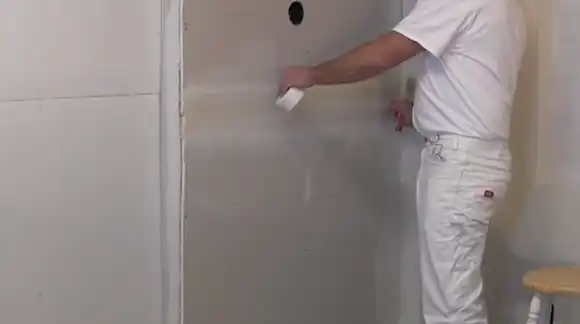
They both serve the same purpose of reinforcing the seams and corners of a drywall panel but differ in installation time. Drywall mesh is typically easier and quicker to install than paper tape; it already comes with adhesive on the back, so you can easily attach it to the surface without applying any extra adhesive or mud.
In contrast, paper tape requires that you first spread drywall mud over the wall before you semi-bury the paper tape to reinforce the seams. It takes much longer to do correctly and, as such, puts an additional strain on a DIYer’s timeline for getting the job done.
Topics of Discussion: Is it possible to install stacked stone on painted drywall
04. Finish Quality
The two materials have distinct finish qualities, providing different performance levels in finished walls. Drywall fiberglass mesh tape can be easily applied with a trowel or roller, making it ideal for large drywall repair jobs. When painted, the surface has an orange peel-like texture that is highly durable and aesthetically pleasing.
Paper tape has an exceptionally smooth finish, resulting in crisp edges and minimal gaps around fixtures, such as outlets or switches. But, due to its lightweight composition, the paper tape may not provide the same crack prevention as mesh over time.
05. Longevity
Mesh tape is made from aluminum, fiberglass, or plastic and is embedded with a glass fiber mesh reinforcing layer. This makes it incredibly durable and able to resist shrinking over time due to environmental changes like humidity.
Paper tape is made of heavy paper, which can become brittle and degraded when exposed repeatedly to moist conditions inside walls. Also, because of its porous nature, paper tape relies on caulking compound sealants which can have poor adhesion over time if not applied properly.
Is Drywall Mesh Tape Paintable?

Drywall mesh tape is designed to be used along seams, cracks, and joints in drywall ceilings and walls but many users are curious if this type of tape is paintable or not. The good news is that it is possible to paint over depending on the material.
Vinyl-coated mesh tapes are usually readily accepted by most paints or primers, as the adhesive side of the tape will absorb into the primer easily. Other types of mesh tapes, such as paper-backed or fiberglass tapes, may first be primed before painting over them.
This helps them blend into the wall more effectively and prevents mildew from forming due to moisture trapped beneath the taped joints.
What Compound Do You Use With Drywall Mesh Tape?
You must use the proper compound with your drywall mesh fiberglass tape to ensure the best results. But most commonly, this is a wet joint drywall compound like mud (such as 3M fiber-reinforced joint compounds, Red Devil lightweight compound, or Gorilla heavy-duty drywall compound).
This joint compound allows you to spread it quickly and evenly over the tape before sanding or mudding subsequent layers of drywall. Before application, ensure that any areas needing patching have been completely cleared of any stubborn debris.
Should You Mud Inside Drywall Joining Corners With Mesh Tape?
The answer is yes if you are wondering whether you should use fiberglass mesh tape to join drywall corners. Doing so helps create a smooth and durable finish by filling any gaps or inconsistencies in the wall.
This is especially important when drywalling an uneven drywall corner where two walls meet, as it ensures a strong bond between them before applying drywall mesh tape. Mud will help cover imperfections and flaws, leaving behind a perfect finish that looks great and provides extra support for mesh fiberglass tape.
Is Fiberglass Drywall Mesh Tape Crack Proof?
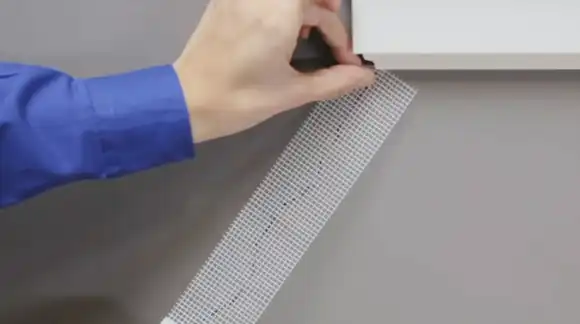
While it is true that fiberglass drywall mesh tapes are designed to create an ideal environment for reinforcing joint compounds, repairs, plaster, and other materials, they are not crack-proof. Most commonly used drywall mesh tapes are prone to shrinkage due to temperature fluctuations and environmental changes.
Also, the adhesive used on the back of the tape can become brittle over time which can cause it to weaken and allow minor drywall cracks to appear.
To ensure the best results and maximum crack prevention, use a quality joint compound with your fiberglass drywall mesh tape and follow the manufacturer’s instructions carefully.
Does Mesh Tape Prevent Crack Well Instead of Paper Tape?
Drywall mesh tape is a popular choice, as it’s easier to apply than paper tape and doesn’t require the application of mesh pieces over the entire crack length. But, when it comes to durability, paper tape is still superior.
Unlike fiberglass mesh tape, paper tape provides a tight seal that can last for years without additional work. To successfully use mesh tape rather than paper tape, experts recommend covering the entire crack with several compound layers. Any uncovered areas will open up soon after you finish taping.
Do Professionals Use Paper Tape for Interior Drywall?
Many professional workers favor paper tape when taping and finishing drywall for various reasons. Paper tape is relatively affordable and easy to use. It’s stronger than mesh yet lighter and thinner than other alternatives.
It also applies smoothly and covers all seams for a more finished appearance. Also, paper tape is more moisture-resistant than mesh, making it the preferred choice for high-humidity areas.
Regardless of your application needs, paper tape is an excellent option for adding strength and durability to any drywall job.
Should You Wet Drywall Paper Tape Before Applying it?
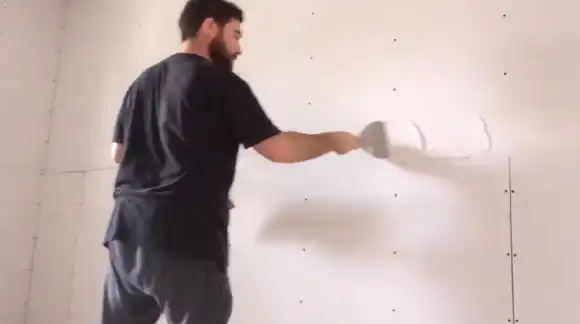
Applying the tape in its dry state can often result in dimpled, bumpy joint lines or even bubbles left behind when it dries. The solution to this problem is wetting the paper tape before embedding it in the joint compound.
Doing so will help the moisture to evaporate while ensuring that your joint is smooth and bubble-free after it has dried gradually. Also, applying pressure along both sides of your taped joint will help further secure air pockets and ensure a strong bond between the drywall and joint compound.
Although wetting your drywall paper tape before applying may take an additional step or two, it’s worth doing if you want a finish that looks professional without bubbles disrupting your work.
Drywall Mesh Tape or Paper Tape: Which Jointing Tape Gives the Strongest Joint to Drywall Seams?
For making a strong, long-lasting joint in drywall seams & corners, it is a common decision to choose between paper drywall tape and mesh drywall tape.
While both tapes share the ability to do an excellent job of concealing joints, paper drywall tape is less expensive and very user-friendly, and provides a solid joint instead of mesh fiberglass tape. It can also be applied with water-activated adhesives that keep the tape firmly in place even when exposed to excess moisture.
Mesh drywall tape has increased strength due to its strong fibers, making it the ideal choice for use on curved surfaces, which are difficult to cover using paper drywall tape. Ultimately, choosing the proper drywall jointing tape for your project is essential, as it will determine the strength and durability of the finished job.
A Similar Topic:
